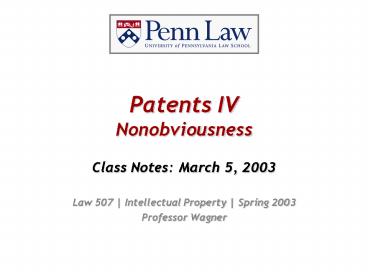Patents IV Nonobviousness - PowerPoint PPT Presentation
1 / 18
Title:
Patents IV Nonobviousness
Description:
Law 507 | Spring 2003. Today's Agenda. Clean Up: Priority Analysis. The Nonobviousness Requirement ... Law 507 | Spring 2003. Priority of Invention. The Basic ... – PowerPoint PPT presentation
Number of Views:66
Avg rating:3.0/5.0
Title: Patents IV Nonobviousness
1
Patents IVNonobviousness
- Class Notes March 5, 2003
- Law 507 Intellectual Property Spring 2003
- Professor Wagner
2
Todays Agenda
- Clean Up Priority Analysis
- The Nonobviousness Requirement
- The Graham Framework
- Challenge 1 Combining References
- Challenge 2 Secondary Considerations
- Challenge 3 Software Business Models
3
Priority of Invention
- The Basic Rule of Priority
- First to reduce to practice priority
- Exception A Prior conception reasonable
diligence until reduction to practice. - Exception B The original inventor abandons,
suppresses, or conceals her invention.
4
Priority of Invention
5
Priority of Invention
- Griffith v Kanamaru (1987)
- Issue what is meant by reasonable diligence?
- Await confirmation of funding sources?
- Await matriculation of graduate student?
- What types of delays are reasonable?
- Key point assume an inventor does set aside her
invention for an unreasonable time/reason - Is she unable to seek a patent? (Under what
circumstances?)
6
Review Requirements for Patentability
- A valid patent must be . . .
- Fully disclosed ( 112)
- Novel ( 102)
- Not subject to a statutory bar ( 102)
- Nonobvious ( 103)
- Within the appropriate subject matter. (March 19)
7
Obviousness History
- Why require something beyond novelty?
- Hotchkiss
- Prior art metallic doorknobs with particular
hole - Invention clay or porcelain doorknob, same hole
- Court no patent a patent requires more
ingenuity and skill than that of a simple
mechanic - Subsequent tests
- requirement for invention
- flash of creative genius requirement
- Is there a problem with this?
8
Obviousness
- 35 U.S.C. 103. - Conditions for patentability
non-obvious subject matter - (a) A patent may not be obtained though the
invention is not identically disclosed or
described as set forth in section 102 of this
title, if the differences between the subject
matter sought to be patented and the prior art
are such that the subject matter as a whole would
have been obvious at the time the invention was
made to a person having ordinary skill in the art
to which said subject matter pertains.
Patentability shall not be negatived by the
manner in which the invention was made.
9
Obviousness Graham
- Graham v John Deere (1966)
- Establishes the Graham Framework for obviousness
analysis. - The ultimate question of obviousness is one of
law (for the court) - The analysis requires three factual
considerations - Scope and content of the prior art
- Differences between the prior art and the
invention - The level of ordinary skill in the pertinent art
10
Graham in Action
11
Graham in Action
12
Challenge 1 Combining References
- Recall under 102 - each element of the claim
must be found in the same document/reference - Under 103, you can combine references to
identify all elements. - What is the primary challenge with this?
- How do you deal with it?
13
Challenge 1 Combining References
- How to limit combining references?
- In re Vaeck/Dembiczak
- Require teaching, suggestion, or motivation to
combine references - Require reasonable expectation of success in
combinations - Where can you find teachings?
14
(No Transcript)
15
Challenge 2 Secondary Considerations
- Note the Federal Circuit in 1980s
- jurisprudentially inappropriate to exclude
consideration of secondary factors (Why?) - The factors (Which - if any - are probative?)
- Commercial success
- Long-felt need / failure of others
- Evidence of copying
- Skepticism (prior to invention) / praise (after
invention) - Licensing/acquiescence to the patent
16
Challenge 3 Software/Business Models
- Why do software and business model patents offer
such a challenge? - How should the courts deal with this?
- Lockwood v. American Airlines (1997)
- Do you agree with the court that the lack of
detail about the software component was fatal? - What does this suggest about software patents?
17
Challenge 3 Software/Business Models
- Amazon.com v Barnesandnoble.com (2001)
- Note the procedural posture.
- What do you think the court suggests about the
validity of the one-click patent? - What does the courts analysis suggest about
software/business method/Internet patents more
generally? - Is there a problem here?
18
- Next Class
- Patents V
- Claim Construction































